Institute of Medicine (IOM) Reports
 The National Academy of Sciences (NAS) was established in 1863 under President Abraham Lincoln's administration to report on science to policymakers and the public. In 1970 the Institute of Medicine (IOM) of NAS – renamed the National Academy of Medcine in 2015 - was chartered as the health arm of the NAS to provide evidence to the government and private sector that would assist in informed health decisions.
The National Academy of Sciences (NAS) was established in 1863 under President Abraham Lincoln's administration to report on science to policymakers and the public. In 1970 the Institute of Medicine (IOM) of NAS – renamed the National Academy of Medcine in 2015 - was chartered as the health arm of the NAS to provide evidence to the government and private sector that would assist in informed health decisions.
In the National Childhood Vaccine Injury Act of 1986, and Congress directed DHHS to contract with the Institute of Medicine (IOM), to evaluate and report on adverse effects of federally recommended childhood vaccines. Beginning in 1990, IOM appointed committees of experts to review the evidence in the medical literature and from other sources on the safety of government recommended and mandated childhood vaccines.
NVIC’s co-founder and president Barbara Loe Fisher was invited to participate as a consumer representative on an Institute of Medicine Vaccine Safety Forum, which sponsored public vaccine safety workshops and published reports on vaccine adverse detection and response and vaccine safety research, and she was a co-editor of the Forum’s 1997 report on Risk Communication and Vaccination. Barbara was also invited to make presentations to IOM expert committees reviewing the evidence for vaccine risks in 2001 and 2012.
In 2015 the National Academy of Sciences rebranded the IOM as the National Academy of Medicine (NAM). Below is additional information on these vaccine safety reports and NVIC's statements to the IOM/NAM.
IOM published a series of reports on evidence for adverse effects of vaccines between 1991 and 2013 confirming that:
- Vaccines can and do carry risks for complications that can be greater for some individuals than others and may lead to chronic brain and immune system damage or death. IOM committees published reports in 1991, 1994a, 1994b, and 2012 and found that the following health problems are causally related to vaccination:
- Acute encephalopathy (brain inflammation)
- Chronic Nervous System Dysfunction (brain damage)
- Anaphylaxis (whole-body allergic reaction)
- Febrile Seizures (convulsions with fever)
- Guillain-Barre Syndrome (peripheral nerve inflammation)
- Brachial Neuritis (arm nerve inflammation)
- Deltoid Bursitis (shoulder inflammation)
- Acute & Chronic Arthritis (joint inflammation)
- Syncope (sudden loss of consciousness/fainting)
- Hypotonic/Hyporesponsive Episodes (shock and “unusual shock-like state)
- Protracted, Inconsolable Crying and Screaming
- Vaccine Strain Infection (smallpox, live polio, measles, varicella zoster vaccines)
- Death (smallpox, live polio, measles vaccines)
- IOM published a report in 2012 revealing that there were continuing significant gaps in scientific knowledge about the biological mechanisms of vaccine injury and death, a point that was made two decades earlier in 1991 and 1994 IOM reports. Because there are not enough methodologically sound epidemiological and biological mechanism studies evaluating vaccine adverse events, the IOM committee could not come to definitive conclusions about causation for many of the reported vaccine reactions involving chronic brain and immune system dysfunction and death. The Committee also concluded that some individuals are more susceptible to vaccine reactions for genetic, biological, environmental and other reasons that have not been fully identified.
-
For eight routinely used vaccines, (MMR, DTaP, hepatitis B, hepatitis A, varicella zoster and meningococcal) there were too few scientifically sound studies published in the medical literature to determine whether more than 100 serious brain and immune system problems are or are not caused by the vaccines, including multiple sclerosis, arthritis, lupus, stroke, SIDS, autism and asthma.
-
Both epidemiologic and biological mechanism research suggest that there are known and unknown biological, genetic and environmental high risk factors, which can increase “individual susceptibility” to vaccine reactions. These predispositions can include genetic variants (in human or microbiome DNA), environmental exposures, behaviors and illness or developmental stage, all of which can interact and, while some of the predispositions may be detectable before vaccination, others are not.
- IOM published a report in 2013 that revealed the federally recommended birth to six-year old child vaccine schedule had not been fully scientifically evaluated and there was not enough scientific evidence for physician committees to determine if the childhood vaccine schedule is or is not associated with the development of the following brain and immune system disorders prevalent among children today:
- Asthma
- Atopy
- Allergy
- Autoimmunity
- Autism
- Learning disorders
- Communication disorders
- Developmental disorders
- Intellectual disability
- Attention deficit disorder
- Disruptive behavior disorder
- Tics and Tourette’s syndrome
- Seizures
- Febrile seizures
- Epilepsy
Since 1982, NVIC has advocated that well-designed, independent, on-going scientific studies must be conducted to: (1) define the various biological mechanisms involved in vaccine injury and death: (2) identify genetic and other biological high risk factors for suffering chronic brain and immune system dysfunction after vaccination; and (3) evaluate short and long-term health outcomes of individuals, who use many vaccines, and those, who use fewer or no vaccines, to determine the health effects of vaccination on individuals and the public health.
Congress Asks IOM To Look At Vaccine Safety: The National Vaccine Information Center, (NVIC) founded by parents of vaccine injured children in 1982, supported a provision in the 1986 National Childhood Vaccine Injury Act in which Congress asked the IOM to assemble independent physician committees to review the medical literature for scientific evidence for a causal relationship between childhood vaccines and immune and neurological dysfunction. NVIC assisted the IOM committees in the early 1990’s by providing information about vaccine reactions. Four landmark reports were published by IOM in 1991 and 1994, including Adverse Effects of Pertussis and Rubella Vaccines; Adverse Events Associated with Childhood Vaccines; DPT Vaccine and Chronic Nervous System Dysfunction: A New Analysis; and Research Strategies for Assessing Adverse Events Associated with Vaccines.
These IOM vaccine study committees and their reports were supported by funds coordinated through the National Institute of Allergy and Infectious Diseases of the National Institutes of Health.
IOM Creates Vaccine Safety Forum: In 1995, the IOM established a Vaccine Safety Forum to examine critical issues relevant to the safety of vaccines used in the U.S. and to discuss methods for improving the safety of vaccines and vaccination programs. NVIC co-founder and president, Barbara Loe Fisher, was appointed to the forum, which included individuals representing parent groups, vaccine manufacturers, physicians, academic researchers and representatives from federal agencies. The IOM Vaccine Safety Forum held five public workshops on vaccine safety and published three reports: Options for Poliomyelitis Vaccination in the United States; Summaries of Two Workshops (“Detecting and Responding to Adverse Events Following Vaccination” and “Research to Identify Risks for Adverse Events Following Vaccination: Biological Mechanisms and Possible Means of Prevention”); and Risk Communication and Vaccination.
The IOM Vaccine Safety Forum was supported by funds coordinated through the National Vaccine Program Office of the Public Health Service and by contributions from Connaught Laboratories and from Merck Research Laboratories.
Below are links to selected statements made by NVIC since the passage of the National Childhood Vaccine Injury Act of 1986 to the IOM in the accomplishment of our vaccine safety and research advocacy goals.
- NVIC's Statement on Childhood Immunization Schedule and Safety: Stakeholder Concerns, Scientific Evidence, and Future Studies - Jan. 16, 2013
- NVIC's Statement on Conducting Research into Health Outcomes of Vaccinated and Unvaccinated Children - Feb. 9, 2012
- NVIC's Statement on the Institute of Medicine Report on Adverse Effects of Vaccines - Aug. 25, 2011
- IOM Committee on NIP's Procedures & Data Sharing Program - Aug. 23, 2004
- IOM Safety Review Committee: Vaccine Safety Research & Reports - Jan. 2001
- Institute of Medicine Immunization Safety Committee - Jan. 11, 2001
- IOM Vaccine Safety Forum Workshop on Risk Communication & Vaccination - May 13, 1996
- Statement on Vaccine Safety Research Needs - Perspective From Parents - April 1, 1996
- Statement on Vaccine Adverse Event Report Reponse Methodologies - Nov. 6, 1995
- Statement on Vaccine Adverse Event Reporting & Data Collection - Nov. 6, 1995
- Statement on Vaccine Adverse Event Detection Methodologies - Nov. 6, 1995
- IOM Vaccine Safety Forum Statement: Where we stand? - Nov. 6, 1995
- NVIC Statement Opposing Continued Use of Live Oral Polio Vaccine (OPV) - June 7, 1995
For over two decades, the Institute of Medicine (IOM), National Academy of Sciences, has assembled committees to examine vaccine research, policy and safety issues. The Institute of Medicine was chartered in 1970 by the National Academy of Sciences to “enlist distinguished members of the appropriate professions in the examination of policy matters pertaining to the health of the public.” The IOM acts under the Academy’s 1863 congressional charter responsibility to be an adviser to the federal government and also initiate the identification of issues of medical care, research and education. Below are links to reports issued that relate to vaccine safety. Additional studies can be viewed on the National Academies of Science website.
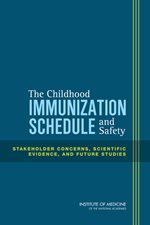 Childhood Immunization Schedule and Safety: Stakeholder Concerns, Scientific Evidence, and Future Studies: Released January 16, 2013 - A report from the Institute of Medicine, examines evidence about the schedule's safety and recommends the best way to conduct any needed investigations. Read NVIC's summary of this report's vaccine safety science gaps. Childhood Immunization Schedule and Safety: Stakeholder Concerns, Scientific Evidence, and Future Studies: Released January 16, 2013 - A report from the Institute of Medicine, examines evidence about the schedule's safety and recommends the best way to conduct any needed investigations. Read NVIC's summary of this report's vaccine safety science gaps. |
|
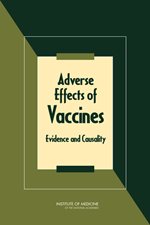 Adverse Effects of Vaccines: Evidence and Causality: Published by the Institute of Medicine (2012). Reviews the epidemiological, clinical, and biological evidence regarding adverse health events associated with specific vaccines covered by the National Vaccine Injury Compensation Program (VICP), including the varicella zoster vaccine, influenza vaccines, the hepatitis B vaccine, and the human papillomavirus vaccine, among others. Adverse Effects of Vaccines: Evidence and Causality: Published by the Institute of Medicine (2012). Reviews the epidemiological, clinical, and biological evidence regarding adverse health events associated with specific vaccines covered by the National Vaccine Injury Compensation Program (VICP), including the varicella zoster vaccine, influenza vaccines, the hepatitis B vaccine, and the human papillomavirus vaccine, among others.NVIC Note: This report investigated 158 of the most commonly reported vaccine adverse events and for 85%, or 135, of these events the IOM was prevented from determining causality due to either an absence of science, or the lack of quality science. |
|
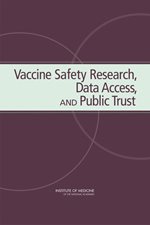 Vaccine Safety Research, Data Access, and Public Trust: Published by the Institute of Medicine (2005). In this report, the committee was asked to review aspects of the U.S. Center for Disease Control's (CDC) Vaccine Safety Datalink (VSD) datasharing program. The IOM found that the datasharing program was not a traditional datasharing program; recommended that independent researchers have access to core data to prove or disprove CDC VSD and VSD partner findings; and that the CDC obtain legal advice relating to federal requirements for public access to data. The report also recommended that two new oversight groups be implemented to ensure that the policies and procedures of the VSD and its data sharing program are implemented as fairly and openly as possible. Vaccine Safety Research, Data Access, and Public Trust: Published by the Institute of Medicine (2005). In this report, the committee was asked to review aspects of the U.S. Center for Disease Control's (CDC) Vaccine Safety Datalink (VSD) datasharing program. The IOM found that the datasharing program was not a traditional datasharing program; recommended that independent researchers have access to core data to prove or disprove CDC VSD and VSD partner findings; and that the CDC obtain legal advice relating to federal requirements for public access to data. The report also recommended that two new oversight groups be implemented to ensure that the policies and procedures of the VSD and its data sharing program are implemented as fairly and openly as possible. |
|
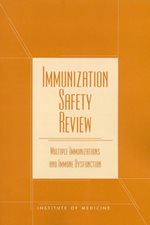 Multiple Immunizations and Immune Dysfunction: Published by the Institute of Medicine (2002). The report states that "The committee recommends limited but continued public health attention to this issue in terms of capitalizing on current research efforts. No recommendations for policy review is made, but the committee does recommend an analysis of new frameworks for immunization policy, particularly as the number of licensed vaccines increases." Multiple Immunizations and Immune Dysfunction: Published by the Institute of Medicine (2002). The report states that "The committee recommends limited but continued public health attention to this issue in terms of capitalizing on current research efforts. No recommendations for policy review is made, but the committee does recommend an analysis of new frameworks for immunization policy, particularly as the number of licensed vaccines increases." |
|
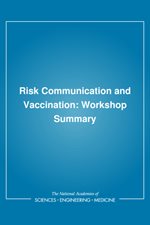 Risk Communication and Vaccination: Workshop Summary: Published by the Institute of Medicine (1997). The forum convened a workshop on risk communication and vaccination. Workshop speakers and participants discussed key concepts in risk communication, unique aspects of communicating risks about vaccines, and current practices in vaccine risk communication. Risk Communication and Vaccination: Workshop Summary: Published by the Institute of Medicine (1997). The forum convened a workshop on risk communication and vaccination. Workshop speakers and participants discussed key concepts in risk communication, unique aspects of communicating risks about vaccines, and current practices in vaccine risk communication. |
|
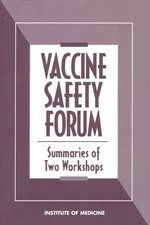 Vaccine Safety Forum: Summaries of Two Workshops: Published by the Institute of Medicine (1997). The Vaccine Safety Forum convened a workshop entitled Research to Identify Risks for Adverse Events Following Vaccination: Mechanisms and Possible Means of Prevention. The workshop discussed the various immunologic and genetic factors that might influence individuals' responses to vaccines, current research aimed at assessing what populations are at increased risk for experiencing adverse events from vaccines, and research avenues that could be pursued in this regard. Vaccine Safety Forum: Summaries of Two Workshops: Published by the Institute of Medicine (1997). The Vaccine Safety Forum convened a workshop entitled Research to Identify Risks for Adverse Events Following Vaccination: Mechanisms and Possible Means of Prevention. The workshop discussed the various immunologic and genetic factors that might influence individuals' responses to vaccines, current research aimed at assessing what populations are at increased risk for experiencing adverse events from vaccines, and research avenues that could be pursued in this regard. |
|
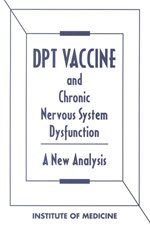 DPT Vaccine and Chronic Nervous System Dysfunction: A New Analysis: Published by the Institute of Medicine in 1994. The committee concluded that the evidence is consistent with a causal relation between vaccination with DPT and acute encephalopathy (IOM, 1991), and the excess risk was estimated to range from 0 to 10.5 per million DPT immunizations. DPT Vaccine and Chronic Nervous System Dysfunction: A New Analysis: Published by the Institute of Medicine in 1994. The committee concluded that the evidence is consistent with a causal relation between vaccination with DPT and acute encephalopathy (IOM, 1991), and the excess risk was estimated to range from 0 to 10.5 per million DPT immunizations. |
|
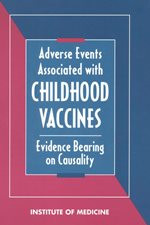 Adverse Events Associated with Childhood Vaccines: Evidence Bearing on Causality: Published by the Institute of Medicine (1994) for the U.S. Congress under the National Childhood Vaccine Injury Act of 1986.A review of the medical literature that documents evidence for and against a causal relationship between tetanus, diphtheria, polio, measles, mumps, rubella, HIB and hepatitis B vaccines and brain and immune system dysfunction. Adverse Events Associated with Childhood Vaccines: Evidence Bearing on Causality: Published by the Institute of Medicine (1994) for the U.S. Congress under the National Childhood Vaccine Injury Act of 1986.A review of the medical literature that documents evidence for and against a causal relationship between tetanus, diphtheria, polio, measles, mumps, rubella, HIB and hepatitis B vaccines and brain and immune system dysfunction. |
|
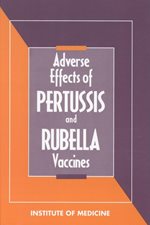 Adverse Effects of Pertussis and Rubella Vaccines: Published by the Institute of Medicine (1991) for the U.S. Congress under the National Childhood Vaccine Injury Act of 1986. A review of the medical literature that documents evidence for and against a causal relationship between pertussis and rubella vaccines and brain and immune system dysfunction. Adverse Effects of Pertussis and Rubella Vaccines: Published by the Institute of Medicine (1991) for the U.S. Congress under the National Childhood Vaccine Injury Act of 1986. A review of the medical literature that documents evidence for and against a causal relationship between pertussis and rubella vaccines and brain and immune system dysfunction. |
Below are links to additional law and policy resources: